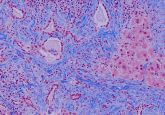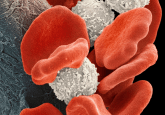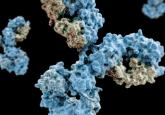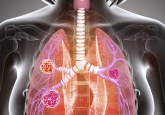Predicting treatment response in ovarian cancer: a peek behind the DISCOVAR trial
Hello, and welcome to this episode of OC Talks Podcast Series brought to you by Oncology Central. I am Jade Parker, Senior Editor of Oncology Central, a free online platform that unites all aspects of oncology to support a multidisciplinary approach to progression of the field. In this episode today of OC talks we will be speaking to Nandita deSouza from the Institute of Cancer Research and the Royal Marsden Hospital (both London, UK) to discuss the Cancer Research UK funded DISCOVAR trial. Thank you for joining us Nandita.
Could you start off by giving us a brief overview of the DISCOVAR trial?
The DISCOVAR trial is an imaging biomarker trial in ovarian cancer. It uses a quantitative imaging biomarker (the apparent diffusion coefficient, ADC) that we generate with Magnetic Resonance Imaging to assess response. In DISCOVAR, we assessed response to standard of care in chemotherapy. Ovarian cancer when first diagnosed is treated with platinum-based chemotherapy. The disease usually responds extremely well at the outset but unfortunately, it then recurs. At that point, patients are re-challenged with platinum-based therapy and they respond again, but less well. Each time platinum-based chemotherapy is reintroduced there is an attrition as the patients respond less and less well. The important thing is to be able to introduce newer therapies at a time at which the disease is becoming resistant to platinum because that gives the patient the best chance for improved progression-free survival.
We wanted to know whether we could develop an imaging biomarker that told us how well the disease was responding to treatment. We looked at cohorts of treatment-naïve (newly diagnosed) and relapsed-disease patients and did three imaging scans in each of them because we thought it was too great a burden for patients to have more than three scans; patients usually have metastatic disease at presentation and are unwell and become even more unwell on chemotherapy.
When any kind of quantification is being performed, the variability of the measurement must be established. A very variable measurement is no good as a response biomarker because changes may be due to measurement variability rather than to response. So, in the treatment-naive patients (i.e. newly diagnosed patients) where we knew a good response to platinum-based chemotherapy was likely, we did two examinations at baseline and used that double baseline examination to assess the variability of the ADC measurement. Then we did one scan after three cycles of chemotherapy immediately prior to surgery, so that we could use that to assess response in the treatment-naive group.
In the patients with relapsed disease who were being treated for a second or third time with platinum-based chemotherapy, we did one scan at baseline (because we had the variability of the measurement data from the other cohort). Then we scanned them early, after one cycle of chemotherapy, and then later after three cycles of chemotherapy. We chose the post-three cycle time-point as the later time point to match the time-point at which we scanned the treatment-naïve patients in the first group.
Could you give us a bit more detail on how this study may aid our understanding of the cancer patient’s prognosis and likely response to treatment?
One of the key things here which I have not yet mentioned is that this was a multicenter national trial, which Cancer Research UK funded. One of the difficulties with imaging biomarkers is that setting standards across multiple institutions and multiple vendor platforms is quite difficult. It’s quite a big hurdle that people probably do not appreciate; scans may not vary much within an institution, but actually across institutions and across vendor platforms (Philips, Siemens, GE), the measurements can be quite different. What we wanted to establish first was whether we could do this in a national trial setting.
One of the outputs from this trial therefore was establishing that we could standardize our measurement process to achieve comparable results across centers and vendor platforms. We set a standard protocol and performed quality assurance across all the centers some of which were high-throughput oncology centers, and some were not. We had The Royal Marsden Hospital, Cambridge Addenbrookes Hospital, Imperial Healthcare partners, Swansea Hospitals and Mount Vernon Hospital in this consortium. We all had different scanners. We established the variability of the measurement and showed that it was less than 10%. This meant that the estimates of response with the imaging biomarker were meaningful and not ascribed to measurement variability.
I think where this measurement is going to be really important is in relapsed disease (where tumor has come back). In treatment-naïve (newly diagnosed) disease, response is by and large good at the outset although there are always exceptions. In relapsed disease, the tumor is becoming increasingly resistant to the chemotherapy it has been treated with. One of the key findings from the study, is that an early increase in the ADC biomarker (after one cycle of chemotherapy) is related to progression-free survival in patients with relapsed disease. A bigger increase in the ADC biomarker, resulted in a longer progression-free survival.
How do you hope the DISCOVAR trial might affect clinical practice on the frontline of care?
I think there are going to be three areas here. Firstly, if resistance can be detected, chemotherapy can be changed earlier. If there is no increase in the ADC biomarker after 1 cycle of treatment in relapsed patients, a different chemotherapy could be introduced earlier. This is what usually happens at a later time-point when it is evident from lack of shrinkage of the tumor, and no change or increase in the blood biomarker, that the treatment is not working because the tumor is becoming resistant to that particular chemotherapy.
The second thing is that often there are differences between the lesions themselves. As ovarian cancer presents late with disease spread through the abdomen and pelvis there are often dozens of lesions. Pinpointing one in which the biomarker is not changing with chemotherapy is helpful. Resistance may be developing in one lesion, which fails to show response, while others may be responding. Lesions that are not responding, may be identified and resected with a limited surgery.
The third thing is, if there is a robust imaging biomarker, it can be used with blood biomarkers in trials of new agents. We are always looking for new drug promises. Cancer Research UK are also always looking for new agents: olaparib is new agent that’s used in ovarian cancer where there is a particular genetic defect. To monitor the response to new agents, an imaging biomarker that is sensitive to early response, and differential response between lesions, would be very, very useful. Those are three ways this information would impact clinical practice.
What are the next steps for this trial?
Although I have made it sound fairly easy, it’s quite intensive. The first thing is setting standards. We need to ensure that we have standard protocols that are easily implementable in multiple centers that are doing ovarian cancer work. We need to impress on centers the importance of quality assurance when we require measurements from imaging. Merely scanning the patients to get images is insufficient: quality assured images are mandatory. Additionally, automation of some of these processes is essential. Automation is out there. There is a burgeoning field of machine learning and auto segmentation. Individual radiologists drawing around every single visualized lesion is very intensive and also can be error prone. Automated segmentation with some manual supervision would give much more robust and repeatable outcomes, as well as being cheaper in the long run.
Looking towards the future what further advances do you hope to see with respect to say magnetic resonance and cancer imaging in general in the coming few years?
We are always looking for betterment in every avenue. Firstly, better spatial resolution. When we have to cover the whole abdomen and pelvis, from the diaphragm to the pelvic floor, we compromise spatial resolution in favor of coverage. This means that identifying small deposits in ovarian cancer can be challenging. Improving spatial resolution comes at a cost, that is time. Scanning over a longer period gives more signal and helps improve resolution. However, this is not feasible in an unwell patient where they may be asked to lie flat on their back for 45 minutes without moving; this really quite uncomfortable and not really tolerable. Having faster scan times would be a big step forward.
The other thing that is very difficult is motion control. Patients do move during the scans, and we have to adjust the images. Image registration can get rid of motion and make the segmentation of a lesion easier. There are newer technologies that are coming along which fuse MRI with optical images obtained at surgery. Another tool is the HoloLens being launched by Google. Segmenting out the anatomy and the tumor from MRI scans allows them to be projected as a hologram for surgical planning purposes. Responding and resistant lesions can be recognized as a color display hologram using a virtual-reality headset. Surgeons can then plan what is very intensive and difficult surgery before they perform it. This would improve operating times and therefore post-operative morbidity for the patient. I think there’s a lot that can be done going forward, and this is an exciting time.
Closing comments
Only that it’s taken a lot of cooperation from many different specialists in many different areas of skill, radiologists, surgeons, oncologists, pathologists, physicists, imagers, informatics scientists, radiographers, technical staff who have done all the quality assurance at multiple centers throughout the UK. To have had funding from Cancer Research UK to achieve it by bringing together people from such different disciplines nationally has been quite an exciting and enjoyable challenge. It just shows that people can learn each other’s disciplines and work together.
Conclusion
Thank you Nandita. Unfortunately, that’s all we had time for today on this OC talks episode, but you can find out more about the DISCOVAR trial by clicking here. Also, don’t forget to check out our content on www.oncology-central.com, and our social media handles @OncologyCentral on Twitter, Facebook and LinkedIn and @JadeBethParker. Thank you.





